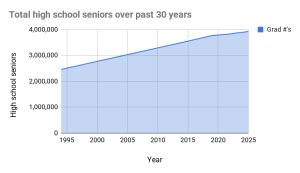Trump elected, contrary to seemingly reliable polls
Unexpected voter turnout has pollsters wondering what….. happened
December 7, 2016
Regardless of political affiliation, the unexpected results of last Tuesday’s presidential election left the nation with a sense of unanticipated confusion.
AP Political Science teacher Alex Zilka remarked that this was most likely due to polling before the election because, “people very much did not expect Trump to win based on the polls.”
Examining some of the most credible names in polling made such a truth evident. A multitude of sources, including Five Thirty Eight and the New York Times, predicted Clinton winning by a landslide.
Five Thirty Eight predicted Clinton’s chance of winning was in the 71st percentile, while the New York Times predicted the possibility of Clinton’s victory to be in the 85th percentile.
Even the popular sketch comedy series Saturday Night Live predicted a Clinton victory, as they referred to her as “president” in one of the many satires of the presidential debates.
Looking at each state individually gives a clear indication of the unpredicted majority Trump received. Not only did he take home the electoral votes from most battleground states, including Florida and Ohio, he also took the majority in states that historically vote democratic and were projected to go for Clinton.
In the end, these states, specifically Wisconsin, Michigan, and Pennsylvania, are what determined Trump’s victory over Clinton.
Given the unanticipated results of these states, it is easy to question the polling that many of us sought out to determine the probability of our candidate’s chances.
However, Zilka said, “Generally polls are pretty accurate. Thinking about the polls in 2012, Obama won in most of the states that he was projected to win in.”
The reasoning behind the inaccurate polling remains ambiguous for most.
In terms of why he thinks the majority of polls were so mistaken, Zilka said, “Pollsters across the board underestimated the participation and enthusiasm of a particular set of the voting population for Donald Trump.
Specifically, this population is comprised of white, working-class people and whites without a college education. Looking at the data, it seems that that group in particular had overwhelming support for Trump beyond their support for Romney in 2012.”
Considering that polls are specifically crafted to represent our nation’s demographic as a whole, it seems odd that the majority of polls omitted a good portion of this year’s voting population.
“My assumption is that when pollsters were weighting the results of their polls, they minimized the impact of that group in the overall poll. Or, another option is that they didn’t reach those people in polling, both of which are problematic. I suspect that it’s actually a combination of the two issues,” Zilka said.
In the end, regardless of anticipated results, Trump took home 290 electoral votes, putting him well over both Clinton’s 232 votes and the minimum of 270 to win the presidency.
Clinton, however, won the popular vote, by the margin of 48% to Trump’s 47%. Libertarian candidate Gary Johnson finished with 3% of the popular vote, while Green Party’s Jill Stein finished with 1%.
In addition to the presidential race, Republicans also won control over both the Senate and the House of Representatives.
They will now hold a majority of 51-48 in the senate, and 239-192 in the House. The last time Republicans controlled all parts of the Executive and Legislative branches was in 1928, almost a full century ago.
For Illinois specifically, Democrat Tammy Duckworth beat out Republican incumbent Mark Kirk for one of Illinois’ Senate seats, and Democratic incumbent Jan Schakowsky beat out Republican Joan Lasonde to represent the 9th district in the House of Representatives. In a very close race, Democrat Brad Schneider beat out Republican incumbent Bob Dold in the 10th district.











































